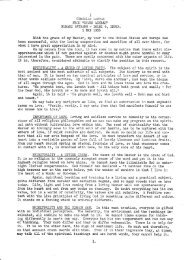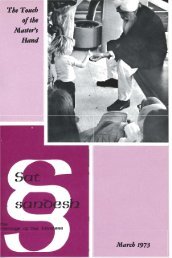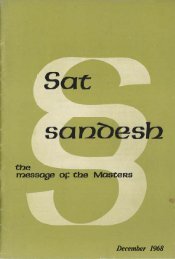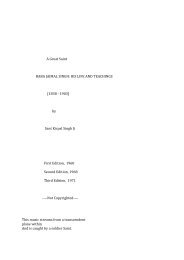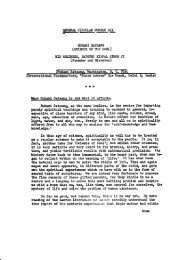- Page 1 and 2:
PRAYER DEFINEDPrayerIts Nature& Tec
- Page 3 and 4:
PRAYER DEFINEDSant Kirpal Singh Ji(
- Page 5 and 6:
PRAYER DEFINEDDedicatedto the Almig
- Page 7 and 8:
PRAYER DEFINEDTo The ReaderMan shal
- Page 9 and 10:
PRAYER DEFINEDTable of Contents1. P
- Page 11 and 12:
PRAYER DEFINEDPrayerxi
- Page 13 and 14:
PRAYER DEFINED1. PrayerPrayer is th
- Page 15 and 16:
PRAYER DEFINEDOn the other hand, a
- Page 17 and 18:
PRAYER DEFINEDSo is the case with t
- Page 19 and 20:
PRAYER PRAYER INSTINCTIVE DEFINEDMA
- Page 21 and 22:
WHOM PRAYER TO DEFINED ADDRESSThrou
- Page 23 and 24:
WHOM PRAYER TO DEFINED ADDRESSCreat
- Page 25 and 26:
WHOM PRAYER TO DEFINED ADDRESSabode
- Page 27 and 28:
WHOM PRAYER TO DEFINED ADDRESSNay,
- Page 29 and 30:
WHOM PRAYER TO DEFINED ADDRESSIt be
- Page 31 and 32:
A DIRECT PRAYER APPEAL DEFINED TO G
- Page 33 and 34:
THE ESSENTIALS PRAYER DEFINED OF PR
- Page 35 and 36:
THE ESSENTIALS PRAYER DEFINED OF PR
- Page 37 and 38:
THE ESSENTIALS PRAYER DEFINED OF PR
- Page 39 and 40:
THE ESSENTIALS PRAYER DEFINED OF PR
- Page 41 and 42:
THE ESSENTIALS PRAYER DEFINED OF PR
- Page 43 and 44:
HOW TO OVERCOME PRAYER DEFINED INNE
- Page 45 and 46:
THE THREE PRAYER TYPES DEFINED OF P
- Page 47 and 48:
THE THREE PRAYER TYPES DEFINED OF P
- Page 49 and 50:
PRAYER LOUD PRAYERS DEFINEDapplause
- Page 51 and 52:
CONGREGATIONAL PRAYER DEFINED PRAYE
- Page 53 and 54:
PLACE PRAYER FOR DEFINED PRAYERIn S
- Page 55 and 56:
PLACE PRAYER FOR DEFINED PRAYERGod
- Page 57 and 58:
PREREQUISITES PRAYER DEFINEDPRAYERA
- Page 59 and 60:
PREREQUISITES PRAYER DEFINEDPRAYERF
- Page 61 and 62:
PREREQUISITES PRAYER DEFINEDPRAYER(
- Page 63 and 64:
PREREQUISITES PRAYER DEFINEDPRAYERa
- Page 65 and 66:
TIME PRAYER FOR DEFINED PRAYER15. T
- Page 67 and 68:
PRAYER DEFINED AND SINfrom being a
- Page 69 and 70:
PRAYERS FOR DEFINED OTHERS18. Praye
- Page 71 and 72:
ACCEPTANCE PRAYER DEFINED OF PRAYER
- Page 73 and 74:
ACCEPTANCE PRAYER DEFINED OF PRAYER
- Page 75 and 76:
NEED PRAYER FOR DEFINED PRAYERKhwaj
- Page 77 and 78:
NEED PRAYER FOR DEFINED PRAYERThe w
- Page 79 and 80:
GRADATIONS PRAYER DEFINEDPRAYEREven
- Page 81 and 82:
GRADATIONS PRAYER DEFINEDPRAYERLet
- Page 83 and 84:
WHAT PRAYER TO ASK DEFINED FROM GOD
- Page 85 and 86:
WHAT PRAYER TO ASK DEFINED FROM GOD
- Page 87 and 88:
WHAT PRAYER TO ASK DEFINED FROM GOD
- Page 89 and 90:
Guru Arjan prayeth:WHAT PRAYER TO A
- Page 91 and 92:
WHAT PRAYER TO ASK DEFINED FROM GOD
- Page 93 and 94:
WHAT PRAYER TO ASK DEFINED FROM GOD
- Page 95 and 96:
WHAT PRAYER TO ASK DEFINED FROM GOD
- Page 97 and 98:
WHAT PRAYER TO ASK DEFINED FROM GOD
- Page 99 and 100:
WHAT PRAYER TO ASK DEFINED FROM GOD
- Page 101 and 102:
WHAT PRAYER TO ASK DEFINED FROM GOD
- Page 103 and 104:
WHAT PRAYER TO ASK DEFINED FROM GOD
- Page 105 and 106:
WHAT PRAYER TO ASK DEFINED FROM GOD
- Page 107 and 108:
WHAT PRAYER TO TO ASK DEFINED FROM
- Page 109 and 110:
GURU IS THE PRAYER GREATEST DEFINED
- Page 111 and 112:
GURU IS THE PRAYER GREATEST DEFINED
- Page 113 and 114:
WHAT ONE SHOULD PRAYER ASK DEFINED
- Page 115 and 116:
WHAT ONE SHOULD PRAYER ASK DEFINED
- Page 117 and 118:
WHAT ONE SHOULD PRAYER ASK DEFINED
- Page 119 and 120:
PRAYER DEFINEDAPPENDIX ASPECIMEN PR
- Page 121 and 122:
APPENDIX PRAYER A — SPECIMEN DEFI
- Page 123 and 124:
APPENDIX PRAYER A — SPECIMEN DEFI
- Page 125 and 126:
APPENDIX PRAYER A — SPECIMEN DEFI
- Page 127 and 128:
APPENDIX PRAYER A — SPECIMEN DEFI
- Page 129 and 130:
APPENDIX PRAYER A — SPECIMEN DEFI
- Page 131 and 132:
APPENDIX PRAYER A — SPECIMEN DEFI
- Page 133 and 134:
APPENDIX PRAYER A — SPECIMEN DEFI
- Page 135 and 136:
APPENDIX PRAYER A — SPECIMEN DEFI
- Page 137 and 138:
APPENDIX PRAYER A — SPECIMEN DEFI
- Page 139 and 140:
APPENDIX PRAYER A — SPECIMEN DEFI
- Page 141 and 142:
APPENDIX PRAYER A — SPECIMEN DEFI
- Page 143 and 144:
APPENDIX PRAYER A — SPECIMEN DEFI
- Page 145 and 146:
APPENDIX PRAYER A — SPECIMEN DEFI
- Page 147 and 148:
APPENDIX PRAYER A — SPECIMEN DEFI
- Page 149 and 150:
APPENDIX PRAYER A — SPECIMEN DEFI
- Page 151 and 152:
APPENDIX PRAYER A — SPECIMEN DEFI
- Page 153 and 154:
APPENDIX PRAYER A — SPECIMEN DEFI
- Page 155 and 156:
APPENDIX PRAYER A — SPECIMEN DEFI
- Page 157 and 158:
APPENDIX PRAYER A — SPECIMEN DEFI
- Page 159 and 160: APPENDIX PRAYER A — SPECIMEN DEFI
- Page 161 and 162: APPENDIX PRAYER A — SPECIMEN DEFI
- Page 163 and 164: APPENDIX PRAYER A — SPECIMEN DEFI
- Page 165 and 166: APPENDIX PRAYER A — SPECIMEN DEFI
- Page 167 and 168: APPENDIX PRAYER A — SPECIMEN DEFI
- Page 169 and 170: APPENDIX PRAYER A — SPECIMEN DEFI
- Page 171 and 172: APPENDIX PRAYER A — SPECIMEN DEFI
- Page 173 and 174: APPENDIX PRAYER A — SPECIMEN DEFI
- Page 175 and 176: APPENDIX PRAYER A — SPECIMEN DEFI
- Page 177 and 178: APPENDIX PRAYER A — SPECIMEN DEFI
- Page 179 and 180: APPENDIX PRAYER A — SPECIMEN DEFI
- Page 181 and 182: PRAYER DEFINED169
- Page 183 and 184: PRAYER DEFINEDREFERENCES171
- Page 185 and 186: PRAYER DEFINEDReferences1. Maru War
- Page 187 and 188: PRAYER REFERENCES DEFINEDAppendix1.
- Page 189 and 190: APPENDIX PRAYER DEFINED B — SIMRA
- Page 191 and 192: PRAYER DEFINEDSant Kirpal Singh Ji(
- Page 193 and 194: PRAYER DEFINEDContentsIntroduction.
- Page 195 and 196: APPENDIX PRAYER B DEFINED — SIMRA
- Page 197 and 198: APPENDIX PRAYER B DEFINED — SIMRA
- Page 199 and 200: APPENDIX PRAYER B DEFINED — SIMRA
- Page 201 and 202: APPENDIX PRAYER B DEFINED — SIMRA
- Page 203 and 204: APPENDIX PRAYER B DEFINED — SIMRA
- Page 205 and 206: APPENDIX PRAYER B DEFINED — SIMRA
- Page 207 and 208: APPENDIX PRAYER B DEFINED — SIMRA
- Page 209: APPENDIX PRAYER B DEFINED — SIMRA
- Page 213 and 214: APPENDIX PRAYER B DEFINED — SIMRA
- Page 215 and 216: APPENDIX PRAYER B DEFINED — SIMRA
- Page 217 and 218: How to Do Simran:APPENDIX PRAYER B
- Page 219 and 220: APPENDIX PRAYER B DEFINED — SIMRA
- Page 221 and 222: APPENDIX PRAYER B DEFINED — SIMRA
- Page 223 and 224: APPENDIX PRAYER B DEFINED — SIMRA
- Page 225 and 226: APPENDIX PRAYER B DEFINED — SIMRA
- Page 227 and 228: APPENDIX PRAYER B DEFINED — SIMRA
- Page 229 and 230: APPENDIX PRAYER B DEFINED — SIMRA
- Page 231 and 232: APPENDIX PRAYER B DEFINED — SIMRA
- Page 233 and 234: APPENDIX PRAYER B DEFINED — SIMRA
- Page 235 and 236: APPENDIX PRAYER B DEFINED — SIMRA
- Page 237 and 238: APPENDIX PRAYER B DEFINED — SIMRA
- Page 239 and 240: APPENDIX PRAYER B DEFINED — SIMRA
- Page 241 and 242: APPENDIX PRAYER B DEFINED — SIMRA
- Page 243 and 244: PRAYER DEFINEDBOOKS by Kirpal Singh
- Page 245 and 246: PRAYER DEFINEDSPIRITUAL ELIXIRColle
- Page 247 and 248: PRAYER PRAYER DEFINEDNOTES235
- Page 249 and 250: PRAYER PRAYER DEFINEDNOTES237
- Page 251 and 252: PRAYER PRAYER DEFINEDNOTES239
- Page 253 and 254: PRAYER PRAYER DEFINEDNOTES241
- Page 255 and 256: PRAYER PRAYER DEFINEDNOTES243
- Page 257: PRAYER APPENDIX PRAYER DEFINED A245




